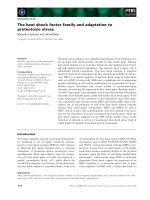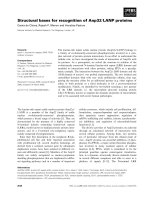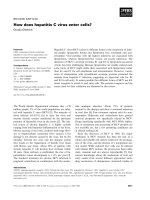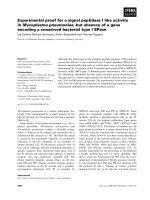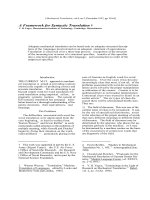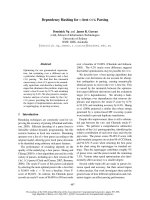Tài liệu Báo cáo khoa học: "Topic Models for Dynamic Translation Model Adaptation" pptx
Bạn đang xem bản rút gọn của tài liệu. Xem và tải ngay bản đầy đủ của tài liệu tại đây (156.93 KB, 5 trang )
Proceedings of the 50th Annual Meeting of the Association for Computational Linguistics, pages 115–119,
Jeju, Republic of Korea, 8-14 July 2012.
c
2012 Association for Computational Linguistics
Topic Models for Dynamic Translation Model Adaptation
Vladimir Eidelman
Computer Science
and UMIACS
University of Maryland
College Park, MD
Jordan Boyd-Graber
iSchool
and UMIACS
University of Maryland
College Park, MD
Philip Resnik
Linguistics
and UMIACS
University of Maryland
College Park, MD
Abstract
We propose an approach that biases machine
translation systems toward relevant transla-
tions based on topic-specific contexts, where
topics are induced in an unsupervised way
using topic models; this can be thought of
as inducing subcorpora for adaptation with-
out any human annotation. We use these topic
distributions to compute topic-dependent lex-
ical weighting probabilities and directly in-
corporate them into our translation model as
features. Conditioning lexical probabilities
on the topic biases translations toward topic-
relevant output, resulting in significant im-
provements of up to 1 BLEU and 3 TER on
Chinese to English translation over a strong
baseline.
1 Introduction
The performance of a statistical machine translation
(SMT) system on a translation task depends largely
on the suitability of the available parallel training
data. Domains (e.g., newswire vs. blogs) may vary
widely in their lexical choices and stylistic prefer-
ences, and what may be preferable in a general set-
ting, or in one domain, is not necessarily preferable
in another domain. Indeed, sometimes the domain
can change the meaning of a phrase entirely.
In a food related context, the Chinese sentence
“粉丝很多 ” (“f
ˇ
ens
¯
i h
ˇ
endu
¯
o”) would mean “They
have a lot of vermicelli”; however, in an informal In-
ternet conversation, this sentence would mean “They
have a lot of fans”. Without the broader context, it
is impossible to determine the correct translation in
otherwise identical sentences.
This problem has led to a substantial amount of
recent work in trying to bias, or adapt, the transla-
tion model (TM) toward particular domains of inter-
est (Axelrod et al., 2011; Foster et al., 2010; Snover
et al., 2008).
1
The intuition behind TM adapta-
tion is to increase the likelihood of selecting rele-
vant phrases for translation. Matsoukas et al. (2009)
introduced assigning a pair of binary features to
each training sentence, indicating sentences’ genre
and collection as a way to capture domains. They
then learn a mapping from these features to sen-
tence weights, use the sentence weights to bias the
model probability estimates and subsequently learn
the model weights. As sentence weights were found
to be most beneficial for lexical weighting, Chiang
et al. (2011) extends the same notion of condition-
ing on provenance (i.e., the origin of the text) by re-
moving the separate mapping step, directly optimiz-
ing the weight of the genre and collection features
by computing a separate word translation table for
each feature, estimated from only those sentences
that comprise that genre or collection.
The common thread throughout prior work is the
concept of a domain. A domain is typically a hard
constraint that is externally imposed and hand la-
beled, such as genre or corpus collection. For ex-
ample, a sentence either comes from newswire, or
weblog, but not both. However, this poses sev-
eral problems. First, since a sentence contributes its
counts only to the translation table for the source it
came from, many word pairs will be unobserved for
a given table. This sparsity requires smoothing. Sec-
ond, we may not know the (sub)corpora our training
1
Language model adaptation is also prevalent but is not the
focus of this work.
115
data come from; and even if we do, “subcorpus” may
not be the most useful notion of domain for better
translations.
We take a finer-grained, flexible, unsupervised ap-
proach for lexical weighting by domain. We induce
unsupervised domains from large corpora, and we
incorporate soft, probabilistic domain membership
into a translation model. Unsupervised modeling of
the training data produces naturally occurring sub-
corpora, generalizing beyond corpus and genre. De-
pending on the model used to select subcorpora, we
can bias our translation toward any arbitrary distinc-
tion. This reduces the problem to identifying what
automatically defined subsets of the training corpus
may be beneficial for translation.
In this work, we consider the underlying latent
topics of the documents (Blei et al., 2003). Topic
modeling has received some use in SMT, for in-
stance Bilingual LSA adaptation (Tam et al., 2007),
and the BiTAM model (Zhao and Xing, 2006),
which uses a bilingual topic model for learning
alignment. In our case, by building a topic distri-
bution for the source side of the training data, we
abstract the notion of domain to include automati-
cally derived subcorpora with probabilistic member-
ship. This topic model infers the topic distribution
of a test set and biases sentence translations to ap-
propriate topics. We accomplish this by introduc-
ing topic dependent lexical probabilities directly as
features in the translation model, and interpolating
them log-linearly with our other features, thus allow-
ing us to discriminatively optimize their weights on
an arbitrary objective function. Incorporating these
features into our hierarchical phrase-based transla-
tion system significantly improved translation per-
formance, by up to 1 BLEU and 3 TER over a strong
Chinese to English baseline.
2 Model Description
Lexical Weighting Lexical weighting features es-
timate the quality of a phrase pair by combining
the lexical translation probabilities of the words in
the phrase
2
(Koehn et al., 2003). Lexical condi-
tional probabilities p(e|f ) are obtained with maxi-
mum likelihood estimates from relative frequencies
2
For hierarchical systems, these correspond to translation
rules.
c(f, e)/
e
c(f, e). Phrase pair probabilities p(e|f )
are computed from these as described in Koehn et
al. (2003).
Chiang et al. (2011) showed that is it benefi-
cial to condition the lexical weighting features on
provenance by assigning each sentence pair a set
of features, f
s
(e|f), one for each domain s, which
compute a new word translation table p
s
(e|f) esti-
mated from only those sentences which belong to s:
c
s
(f, e)/
e
c
s
(f, e), where c
s
(·) is the number of
occurrences of the word pair in s.
Topic Modeling for MT We extend provenance
to cover a set of automatically generated topics z
n
.
Given a parallel training corpus T composed of doc-
uments d
i
, we build a source side topic model over
T , which provides a topic distribution p(z
n
|d
i
) for
z
n
= {1, . . . , K} over each document, using Latent
Dirichlet Allocation (LDA) (Blei et al., 2003). Then,
we assign p(z
n
|d
i
) to be the topic distribution for
every sentence x
j
∈ d
i
, thus enforcing topic sharing
across sentence pairs in the same document instead
of treating them as unrelated. Computing the topic
distribution over a document and assigning it to the
sentences serves to tie the sentences together in the
document context.
To obtain the lexical probability conditioned on
topic distribution, we first compute the expected
count e
z
n
(e, f) of a word pair under topic z
n
:
e
z
n
(e, f) =
d
i
∈T
p(z
n
|d
i
)
x
j
∈d
i
c
j
(e, f) (1)
where c
j
(·) denotes the number of occurrences of
the word pair in sentence x
j
, and then compute:
p
z
n
(e|f) =
e
z
n
(e, f)
e
e
z
n
(e, f)
(2)
Thus, we will introduce 2·K new word trans-
lation tables, one for each p
z
n
(e|f) and p
z
n
(f|e),
and as many new corresponding features f
z
n
(e|f),
f
z
n
(f|e). The actual feature values we compute will
depend on the topic distribution of the document we
are translating. For a test document V , we infer
topic assignments on V , p(z
n
|V ), keeping the topics
found from T fixed. The feature value then becomes
f
z
n
(e|f) = − log
p
z
n
(e|f) · p(z
n
|V )
, a combi-
nation of the topic dependent lexical weight and the
116
topic distribution of the sentence from which we are
extracting the phrase. To optimize the weights of
these features we combine them in our linear model
with the other features when computing the model
score for each phrase pair
3
:
p
λ
p
h
p
(e, f)
unadapted features
+
z
n
λ
z
n
f
z
n
(e|f)
adapted features
(3)
Combining the topic conditioned word translation
table p
z
n
(e|f) computed from the training corpus
with the topic distribution p(z
n
|V ) of the test sen-
tence being translated provides a probability on how
relevant that translation table is to the sentence. This
allows us to bias the translation toward the topic of
the sentence. For example, if topic k is dominant in
T , p
k
(e|f) may be quite large, but if p(k|V ) is very
small, then we should steer away from this phrase
pair and select a competing phrase pair which may
have a lower probability in T , but which is more rel-
evant to the test sentence at hand.
In many cases, document delineations may not be
readily available for the training corpus. Further-
more, a document may be too broad, covering too
many disparate topics, to effectively bias the weights
on a phrase level. For this case, we also propose a
local LDA model (LTM), which treats each sentence
as a separate document.
While Chiang et al. (2011) has to explicitly
smooth the resulting p
s
(e|f), since many word pairs
will be unseen for a given domain s, we are already
performing an implicit form of smoothing (when
computing the expected counts), since each docu-
ment has a distribution over all topics, and therefore
we have some probability of observing each word
pair in every topic.
Feature Representation After obtaining the topic
conditional features, there are two ways to present
them to the model. They could answer the question
F
1
: What is the probability under topic 1, topic 2,
etc., or F
2
: What is the probability under the most
probable topic, second most, etc.
A model using F
1
learns whether a specific topic
is useful for translation, i.e., feature f
1
would be
f
1
:
= p
z=1
(e|f) · p(z = 1|V ). With F
2
, we
3
The unadapted lexical weight p(e|f ) is included in the
model features.
are learning how useful knowledge of the topic dis-
tribution is, i.e., f
1
:
= p
(arg max
z
n
(p(z
n
|V ))
(e|f) ·
p(arg max
z
n
(p(z
n
|V ))|V ).
Using F
1
, if we restrict our topics to have a one-
to-one mapping with genre/collection
4
we see that
our method fully recovers Chiang (2011).
F
1
is appropriate for cross-domain adaptation
when we have advance knowledge that the distribu-
tion of the tuning data will match the test data, as in
Chiang (2011), where they tune and test on web. In
general, we may not know what our data will be, so
this will overfit the tuning set.
F
2
, however, is intuitively what we want, since
we do not want to bias our system toward a spe-
cific distribution, but rather learn to utilize informa-
tion from any topic distribution if it helps us cre-
ate topic relevant translations. F
2
is useful for dy-
namic adaptation, where the adapted feature weight
changes based on the source sentence.
Thus, F
2
is the approach we use in our work,
which allows us to tune our system weights toward
having topic information be useful, not toward a spe-
cific distribution.
3 Experiments
Setup To evaluate our approach, we performed ex-
periments on Chinese to English MT in two set-
tings. First, we use the FBIS corpus as our training
bitext. Since FBIS has document delineations, we
compare local topic modeling (LTM) with model-
ing at the document level (GTM). The second setting
uses the non-UN and non-HK Hansards portions of
the NIST training corpora with LTM only. Table 1
summarizes the data statistics. For both settings,
the data were lowercased, tokenized and aligned us-
ing GIZA++ (Och and Ney, 2003) to obtain bidi-
rectional alignments, which were symmetrized us-
ing the grow-diag-final-and method (Koehn
et al., 2003). The Chinese data were segmented us-
ing the Stanford segmenter. We trained a trigram
LM on the English side of the corpus with an addi-
tional 150M words randomly selected from the non-
NYT and non-LAT portions of the Gigaword v4 cor-
pus using modified Kneser-Ney smoothing (Chen
and Goodman, 1996). We used cdec (Dyer et al.,
4
By having as many topics as genres/collections and setting
p(z
n
|d
i
) to 1 for every sentence in the collection and 0 to ev-
erything else.
117
Corpus Sentences Tokens
En Zh
FBIS 269K 10.3M 7.9M
NIST 1.6M 44.4M 40.4M
Table 1: Corpus statistics
2010) as our decoder, and tuned the parameters of
the system to optimize BLEU (Papineni et al., 2002)
on the NIST MT06 tuning corpus using the Mar-
gin Infused Relaxed Algorithm (MIRA) (Crammer
et al., 2006; Eidelman, 2012). Topic modeling was
performed with Mallet (Mccallum, 2002), a stan-
dard implementation of LDA, using a Chinese sto-
plist and setting the per-document Dirichlet parame-
ter α = 0.01. This setting of was chosen to encour-
age sparse topic assignments, which make induced
subdomains consistent within a document.
Results Results for both settings are shown in Ta-
ble 2. GTM models the latent topics at the document
level, while LTM models each sentence as a separate
document. To evaluate the effect topic granularity
would have on translation, we varied the number of
latent topics in each model to be 5, 10, and 20. On
FBIS, we can see that both models achieve moderate
but consistent gains over the baseline on both BLEU
and TER. The best model, LTM-10, achieves a gain
of about 0.5 and 0.6 BLEU and 2 TER. Although the
performance on BLEU for both the 20 topic models
LTM-20 and GTM-20 is suboptimal, the TER im-
provement is better. Interestingly, the difference in
translation quality between capturing document co-
herence in GTM and modeling purely on the sen-
tence level is not substantial.
5
In fact, the opposite
is true, with the LTM models achieving better per-
formance.
6
On the NIST corpus, LTM-10 again achieves the
best gain of approximately 1 BLEU and up to 3 TER.
LTM performs on par with or better than GTM, and
provides significant gains even in the NIST data set-
ting, showing that this method can be effectively ap-
plied directly on the sentence level to large training
5
An avenue of future work would condition the sentence
topic distribution on a document distribution over topics (Teh
et al., 2006).
6
As an empirical validation of our earlier intuition regarding
feature representation, presenting the features in the form of F
1
caused the performance to remain virtually unchanged from the
baseline model.
Model MT03 MT05
↑BLEU ↓TER ↑BLEU ↓TER
BL 28.72 65.96 27.71 67.58
GTM-5 28.95
ns
65.45 27.98
ns
67.38
ns
GTM-10 29.22 64.47 28.19 66.15
GTM-20 29.19 63.41 28.00
ns
64.89
LTM-5 29.23 64.57 28.19 66.30
LTM-10 29.29 63.98 28.18 65.56
LTM-20 29.09
ns
63.57 27.90
ns
65.17
Model MT03 MT05
↑BLEU ↓TER ↑BLEU ↓TER
BL 34.31 61.14 30.63 65.10
MERT 34.60 60.66 30.53 64.56
LTM-5 35.21 59.48 31.47 62.34
LTM-10 35.32 59.16 31.56 62.01
LTM-20 33.90
ns
60.89
ns
30.12
ns
63.87
Table 2: Performance using FBIS training corpus (top)
and NIST corpus (bottom). Improvements are significant
at the p <0.05 level, except where indicated (
ns
).
corpora which have no document markings. De-
pending on the diversity of training corpus, a vary-
ing number of underlying topics may be appropriate.
However, in both settings, 10 topics performed best.
4 Discussion and Conclusion
Applying SMT to new domains requires techniques
to inform our algorithms how best to adapt. This pa-
per extended the usual notion of domains to finer-
grained topic distributions induced in an unsuper-
vised fashion. We show that incorporating lexi-
cal weighting features conditioned on soft domain
membership directly into our model is an effective
strategy for dynamically biasing SMT towards rele-
vant translations, as evidenced by significant perfor-
mance gains. This method presents several advan-
tages over existing approaches. We can construct
a topic model once on the training data, and use
it infer topics on any test set to adapt the transla-
tion model. We can also incorporate large quanti-
ties of additional data (whether parallel or not) in
the source language to infer better topics without re-
lying on collection or genre annotations. Multilin-
gual topic models (Boyd-Graber and Resnik, 2010)
would provide a technique to use data from multiple
languages to ensure consistent topics.
118
Acknowledgments
Vladimir Eidelman is supported by a National De-
fense Science and Engineering Graduate Fellow-
ship. This work was also supported in part by
NSF grant #1018625, ARL Cooperative Agree-
ment W911NF-09-2-0072, and by the BOLT and
GALE programs of the Defense Advanced Research
Projects Agency, Contracts HR0011-12-C-0015 and
HR0011-06-2-001, respectively. Any opinions, find-
ings, conclusions, or recommendations expressed
are the authors’ and do not necessarily reflect those
of the sponsors.
References
Amittai Axelrod, Xiaodong He, and Jianfeng Gao. 2011.
Domain adaptation via pseudo in-domain data selec-
tion. In Proceedings of Emperical Methods in Natural
Language Processing.
David M. Blei, Andrew Y. Ng, Michael I. Jordan, and
John Lafferty. 2003. Latent Dirichlet Allocation.
Journal of Machine Learning Research, 3:2003.
Jordan Boyd-Graber and Philip Resnik. 2010. Holistic
sentiment analysis across languages: Multilingual su-
pervised latent Dirichlet allocation. In Proceedings of
Emperical Methods in Natural Language Processing.
Stanley F. Chen and Joshua Goodman. 1996. An empir-
ical study of smoothing techniques for language mod-
eling. In Proceedings of the 34th Annual Meeting of
the Association for Computational Linguistics, pages
310–318.
David Chiang, Steve DeNeefe, and Michael Pust. 2011.
Two easy improvements to lexical weighting. In Pro-
ceedings of the Human Language Technology Confer-
ence.
Koby Crammer, Ofer Dekel, Joseph Keshet, Shai Shalev-
Shwartz, and Yoram Singer. 2006. Online passive-
aggressive algorithms. Journal of Machine Learning
Research, 7:551–585.
Chris Dyer, Adam Lopez, Juri Ganitkevitch, Jonathan
Weese, Ferhan Ture, Phil Blunsom, Hendra Setiawan,
Vladimir Eidelman, and Philip Resnik. 2010. cdec: A
decoder, alignment, and learning framework for finite-
state and context-free translation models. In Proceed-
ings of ACL System Demonstrations.
Vladimir Eidelman. 2012. Optimization strategies for
online large-margin learning in machine translation.
In Proceedings of the Seventh Workshop on Statistical
Machine Translation.
George Foster, Cyril Goutte, and Roland Kuhn. 2010.
Discriminative instance weighting for domain adapta-
tion in statistical machine translation. In Proceedings
of Emperical Methods in Natural Language Process-
ing.
Philipp Koehn, Franz Josef Och, and Daniel Marcu.
2003. Statistical phrase-based translation. In Pro-
ceedings of the 2003 Conference of the North Ameri-
can Chapter of the Association for Computational Lin-
guistics on Human Language Technology - Volume 1,
NAACL ’03, Stroudsburg, PA, USA.
Spyros Matsoukas, Antti-Veikko I. Rosti, and Bing
Zhang. 2009. Discriminative corpus weight estima-
tion for machine translation. In Proceedings of Em-
perical Methods in Natural Language Processing.
A. K. Mccallum. 2002. MALLET: A Machine Learning
for Language Toolkit.
Franz Och and Hermann Ney. 2003. A systematic com-
parison of various statistical alignment models. In
Computational Linguistics, volume 29(21), pages 19–
51.
Kishore Papineni, Salim Roukos, Todd Ward, and Wei-
Jing Zhu. 2002. BLEU: a method for automatic evalu-
ation of machine translation. In Proceedings of the As-
sociation for Computational Linguistics, pages 311–
318.
Matthew Snover, Bonnie Dorr, and Richard Schwartz.
2008. Language and translation model adaptation us-
ing comparable corpora. In Proceedings of Emperical
Methods in Natural Language Processing.
Yik-Cheung Tam, Ian Lane, and Tanja Schultz. 2007.
Bilingual LSA-based adaptation for statistical machine
translation. Machine Translation, 21(4):187–207.
Yee Whye Teh, Michael I. Jordan, Matthew J. Beal, and
David M. Blei. 2006. Hierarchical Dirichlet pro-
cesses. Journal of the American Statistical Associa-
tion, 101(476):1566–1581.
Bing Zhao and Eric P. Xing. 2006. BiTAM: Bilingual
topic admixture models for word alignment. In Pro-
ceedings of the Association for Computational Lin-
guistics.
119


